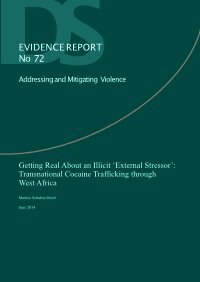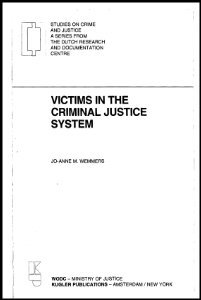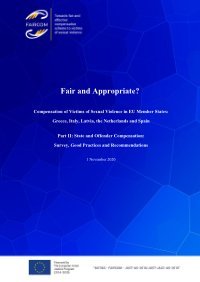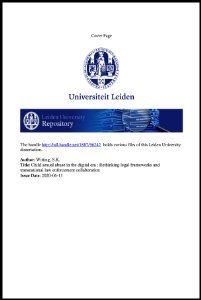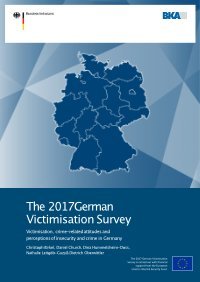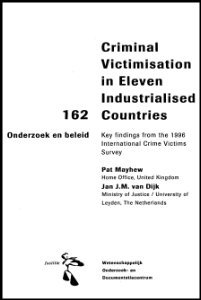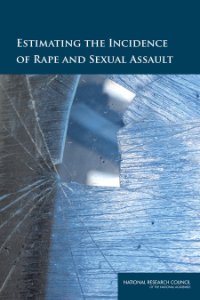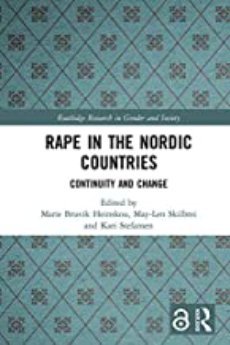By Inka Lilja, Elina Kervinen, Anni Lietonen, Natalia Ollus, Minna Viuhko, Anniina Jokinen.
The HEUNI report "Unseen Victims" presents the manifestations and consequences of gender-based violence and the challenges in assisting victims of violence in the migration context. With this report we aim to increase the understanding of policymakers on the structural challenges asylum-seeking and refugee women who have experienced gender-based violence face.
Helsinki: European Institute for Crime Prevention and Control (HEUNI), 2020. 100p.
Edited by J.A. Wemmers.
In the last fifteen to twenty years, criminal justice policy-makers and government in the Netherlands have begun to realize that victims of crime are often seriously affected by their experience and that reactions by criminal justice authorities are not always supportive. This realization was in part stimulated by the women's movement which drew attention to violence against women and the position of these victims in the criminal justice system. Other developments which have contributed to the increased attention for victims of crime include the rise in the registered crime rate which was at its peak during the seventies and early eighties. Also in the early seventies, the victim survey was introduced. It revealed that the registered crime statistics are incomplete and that only a fraction of crimes are brought to the attention of authorities. At the same time, police were finding it increasingly difficult to solve the crimes which were brought to their attention and the clearance rate began to drop. Authorities realized that they can only do their work if victims are prepared to report crime to them and that their willingness to report crimes is in part dependent on the quality of the relationship between citizens and the justice system.
The Hague: WODC, Ministry of Justice ; Amsterdam : Kugler Publications. 1996. 252p.
By N Elbers; A Akkermans; H Soleto Muñoz; Fiodorova; A Grané; J Maria Tamarit; L Arantegui; P Patrizi; GL Lepri; E Lodi; D Chirico; I Lāce; L Vaivode; J Dilba; A Brekasi; N Zoidou Saripapa; N Spetsidis.
The second eBook of the FAIRCOM Project, available as download on this page, presents the results of an investigative study on State Compensation and Offender Compensation in the current five partner countries: Greece, Italy, Latvia, the Netherlands and Spain. It identifies good practices and offers recommendations.
The last 20 years, victims of crime have received increased attention in the criminal trial process. Various EU legislation, in specific the Victims’ Rights Directive 2012/29/EU,1 has established important victims’ rights, such as the right to receive information, respectful treatment, legal support, victim support and compensation. Most EU member states have implemented the legislation and the position of victims has clearly been strengthened. Now that victims of crime are in the spotlight, it is a good opportunity to also focus on specific vulnerable groups of victims in criminal law: victims of sexual crimes. Victims of sexual crimes require special attention for several reasons. Firstly, the scale in which sexual violence occurs is significant: according to a report of the European Agency for Fundamental Rights (FRA), it is estimated that 3.7 million women in the EU are subjected to sexual violence every year. 2 In total 11% of women have experienced some form of sexual violence since they were 15 years old. 5% of women have been raped since the age of 15. 3 The FRA did not include sexual violence to men. What is known about men is that 10% of victims of violent sexual crimes are men, the majority (90%) of the victims are women. 4 Of the perpetrators, 99% are men, 1% are women. 5 Secondly, victims of sexual crimes need support in their search for justice. Only 14% of victims of sexual violence report their offense to the police.6 Sexual crimes are often associated with shame and stigma and often mentioned in relation to secondary victimisation. About 25% of victims of sexual crimes do not dare to report the crime because of shame and 12% does not report because they think they will not be believed. Victims of physical violence also do not report because of shame or not being believed but the percentages are much lower, respectively 8% and 2%.7 Of the victims of sexual crimes who report to the police, about 46% are not satisfied with the treatment received by the police.
Amsterdam: Free University of Amsterdam, 2020. 94p.
Edited by The Centre for Child Law.
Child victims and witnesses of crime are amongst the most vulnerable people in the justice system. The United Nations issued guidelines for their protection in 2005. This publication sets out the guidelines in the South African context. Does South African law reflect these guidelines? What are the challenges to be faced in order to bring South African law and practice in line with these international standards? Answers to these questions are provided in this up-to-date analysis of the current state of the law. This publication is a useful guide for students of law, as well as for practitioners who work with children in the courts. Launched during the internationally recognised “16 days of activism to end violence against women and children”, the publication is designed to be of assistance in the everyday working life of presiding officers, prosecutors, defence lawyers, social workers, intermediaries and other professionals.
Pretoria: Pretoria University Law Press (PULP), 2008. 59p.
By S.K. Witting.
With access to and usage of it increasing dramatically over the past 20 years, the Internet has become an emerging realm for human interaction. With children constituting one-third of Internet users worldwide, this realm offers endless opportunities to learn, connect, and interact. At the same time, the Internet facilitates child sexual abuse on a large scale – through the production, dissemination, and accessing of child sexual abuse material.This study aims to critically analyse emerging aspects of the international and national regulation, investigation and prosecution of online child sexual abuse material from a child-rights and rule-of-law-based approach. It investigates emerging aspects of substantive and procedural law which have been little explored in the past, zooming in on complex constitutional aspects by applying a comparative legal analysis approach with a strong focus on the Global South as well as interdisciplinary legal research.In order to solve these complex legal issues, the answer lies in the identification and subsequent navigation of a variety of dichotomies that govern the discourse on online child sexual abuse material. The international and national regulation, investigation and prosecution of emerging aspects of online child sexual abuse material hence require constant identification, reflection and calibration of competing discourses, with a view to developing a cyber-specific yet victim-sensitive response that upholds the rule of law and takes a child-centred approach.
Leiden: Leiden University, 2020. 158p.
By J.J. Rokven.
Why do offenders often become victims of crime themselves? And are victims of crime also more likely to become criminal offenders? While criminological research often treats victims and offenders as distinct groups, Von Hentig already in 1948 noted that these groups may overlap. In his textbook, The Criminal and His Victim, Von Hentig criticized the traditional offender=oriented nature of criminology and drew attention to the fact that victims and offenders both play important roles in criminal events and people may alternate between the role of victim and offender. Subsequently, numerous studies have examined the relationship between victimization and offending and virtually all documented a strong connection between the two: those who engage in criminal offending are often also the ones who suffer from it (Fagan, Piper, & Cheng, 1987; Jennings, Piquero, & Reingle, 2011; Jensen & Brownfield, 1986; Lauritsen & Laub, 2007; Lauritsen, Sampson, & Laub, 1991; Ousey, Wilcox, & Fisher, 2011; Sampson & Lauritsen, 1990; Singer, 1981; Smith & Ecob, 2007). Despite the strong empirical evidence for the victimization-offending relationship, the etiology of this relationship is still not well understood. The aim of this study is therefore to provide more insight in the underlying processes that explain this victim-offender overlap.
Nijmegen, Netherlands:Radboud University, 2016. 186p.
By Dr. Christoph Birkel, Daniel Church, Dina Hummelsheim-Doss, Nathalie Leitgöb-Guzy, and Dietrich Oberwittler.
As megatrends, globalisation and digitisation are bringing about rapid changes, including in Germany. They are opening up a range of new opportunities, not only in the fields of economics, science and culture, but also in the way we access information, communicate with each other and participate in political and societal decision-making processes. But these new opportunities are being undermined by a highly uneven distribution of the benefits of globalisation and digitisation. This is a worrying development, since the resulting inequalities not only increase the risk of transnational conflicts, struggles over resource allocation and mass migration, but also threaten civil peace and social cohesion in the societies affected by these developments. The direct and indirect repercussions caused by such tensions are being felt across Germany as well, for instance in the form of an ongoing terrorist threat on our continent, an increasingly harsh political discourse, political radicalisation and forms of politically motivated crime, as well as through the ways in which organised crime and criminal clan structures are challenging the rule of law. These developments are fuelling a feeling of insecurity, which in the wake of digitisation is being amplified by the fact that, on the one hand, access to information is becoming easier, faster and more comprehensive, while, on the other hand, the authenticity of that very information is becoming increasingly difficult to validate. Free and unrestricted access to knowledge and information is a precious good, as it promotes informational participation for broad segments of society and increases transparency and democratic control. At the same time, however, it is also becoming easier to disseminate inaccurate information on a large scale, or even launch targeted disinformation campaigns or manipulate public opinion in a time in which the need for reliable sources is greater than ever. This is especially true for safety, where “fake news” can have a momentous impact in a very short space of time. Although representative studies and surveys have shown the current level of safety in Germany to be relatively high, various surveys have indicated that the German public often perceives the risks to be higher. This is why representative victimisation surveys and other tools are indispensable. They make visible the gap between perception and fear, on the one hand, and statistics and scientific findings, on the other. This knowledge can help us to design targeted information campaigns to dispel such perceived threats and feelings of insecurity. Representative victimisation surveys can also help us to identify actual increases in crime rates, introduce appropriate countermeasures and update official crime figures by shedding light on the dark figure of unreported or hidden crime. In addition, knowing the reasons why victims report, or choose not to report, an offence they have experienced will also allow us to improve criminal prosecution approaches in the future. Enriched by comprehensive insights into crime-relevant factors, victimisation surveys have the potential to deliver the crucial insights needed to successfully address the safety-related challenges of the present. Following up on the first German Victimisation Survey (Deutscher Viktimisierungssurvey, DVS) undertaken in 2012, the 2017 survey provides us with fresh sets of data to assess the development of crime and crime-related attitudes in Germany. Based on a nationwide, representative sample of the German population aged 16 and over, the 2017 survey not only yields insights regarding the current security situation and perceived safety across the population, it also allows us to draw conclusions by looking at the developments and changes since 2012.
Wiesbaden: Bundeskriminalamt - BKA, 2019. 127p.
By J.J.M. van Dijk, P. Mayhew, and M. Killias.
The international victimization survey reported here measured experience of crïme and a number of other crime-related issues in a large number of European and non-European countries. It used tightly standardized methods as regards the sampling procedure, method of interview, questions asked, and analysis of the data. By asking respondents directly about a range of offences that they had experienced over a given time period, the survey provides a measure of the level of crime in different countrïes that is independent of the conventional one of offences recorded by the police. The police measure has well-known limitations for comparative purposes as it is based only on those crimes which are reported to the police by victims, and which are recorded by the police. The value of the survey is that it: - enables individual countries to see how they are faring in comparison with others in relation to crime levels; - provîdes some rough picture of the extent to which survey-measured crime in different countries matches the picture from figures of offences recorded by the police; - provides some basis for explaining major differences in crime experience in terms, for instance, of socio-demographic variables; - allows some examination of the types of people most at risk of victimization for different types of crime, and whether these vaiy across the jurisdictions in the survey; and, finally, - provides information on responses to crime in different countries, such as opinions about the police, appropriate sentences, fear of crime, and the use of various crime prevention measures. These survey results should not be seen as giving a definitive picture of crime, and responses to it in different countries. The samples of respondents interviewed in each country were relatively small, only those with a telephone at home were interviewed, and response rates were not always high. The significance of these factors is taken up in more detail in the final chapter, but the fact remains that the comparable information provided by the international suivey is unique.
Deventer; Boston: Kluwer Law and Taxation Publishers 1990. 191p.
By P. Mayhew, and J.J.M. van Dijk.
The International Crime Victimisation Survey (ICVS) is the most far-reaching programme of fully standardised sample surveys looking at householders' experience of crime in different countries. The first ICVS took place in 1989, the second in 1992, and the third in 1996. Surveys have been carried out in over 50 countries since 1989, including a large number of city surveys in developing countries and countries in transition. This report deals with eleven industrialised countries which took part in the third sweep. The reason for setting up the ICVS was the inadequacy of other measures of crime across country. Figures of offences recorded by the police are problematic due to differences in the way the police define, record and count crime. And since most crimes the police know about are reported by victims, police figures can differ simply because of differences in reporting behaviour. It is also difficult to make comparisons of independently organised crime surveys, as these differ in design and coverage. For the countries covered in this report, interviews were mainly conducted by telephone (with samples selected through variants of random digit dialling). There is no reason to think results are biased because of the telephone mode. Response rates varied hut we show that there is no overriding evidence that this affects the count of victimisation. Samples were usually of 1,000 or 2,000 people which means there is a fairly wide sampling error on the ICVS estimates. The surveys cannot, then, give precise estimates of crime in different countries. But they are a unique source of information and give good comparative information. The results in this report relate mainly to respondents' experience of crime in 1995, the year prior to the 1996 survey. Those interviewed were asked about crimes they had experienced, whether or not reported to the police.
The Hague: WODC, 1997. 116p.
By Jan van Dijk John van Kesteren Paul Smit.
The International Crime Victims Survey became operational in 1989. The main object was to seek advancement in international comparative criminological research, beyond the constraints of officially recorded crime data. The next sweeps of the ICVS surveys took place in 1992, 1996 and 2000. With its fifth sweep in 2005 the initiative has developed into a truly unique global project. Over a time span of fifteen years more than 300,000 people were interviewed about their experiences with victimisation and related subjects in 78 different countries. This report describes the 2004 – 2005 sweep of surveys in 30 countries and 33 capital or main cities and compares results with those of earlier sweeps. A large portion of the latest data in this report comes from the European Survey on Crime and Safety (EU ICS), organised by a consortium lead by Gallup Europe, co-financed by the European Commission’s Directorate General for Research and Technology Development. The ICVS is the most comprehensive instrument developed yet to monitor and study volume crimes, perception of crime and attitudes towards the criminal justice system in a comparative, international perspective. The data are from surveys amongst the general public and therefore not influenced by political or ideological agendas of governments of individual countries. Standardisation of questionnaires used and other aspects of data collection assure that data can, within confidence margins, be reliably compared across countries. Independent reviews have attested to the comparability of ICVS results (e.g. Lynch, 2006). The ICVS started in 1989 in 14 industrialised countries. City surveys were also piloted in Warsaw, Poland and Surabaya, Indonesia. Already in the second sweep coverage was enlarged by including several countries in Eastern Central Europe. Fieldwork in some of these countries was funded by the Ministry for Development Aid of the Netherlands. For these countries the project played a part in the process of modernising criminal justice systems after Western European models. Many of those countries have now become part of the European Union. Where most industrialised countries have a long tradition of publishing statistics on police-recorded crime, in many developing countries crime data are either fragmented, of poor quality or not available to the public. Crime victim surveys in these countries, although restricted to the capital or main cities, is often the only available source of statistical information on crime and victimisation. Internationally comparable crime victim surveys not only serve policy purposes but make data available that can be used by researchers interested in crime in a comparative context, including in developing countries from different regions of the world.
The Hague: WODC; Boom Juridische uitgevers: 2007. 292p.
National Research Council
The Bureau of Justice Statistics' (BJS) National Crime Victimization Survey (NCVS) measures the rates at which Americans are victims of crimes, including rape and sexual assault, but there is concern that rape and sexual assault are undercounted on this survey. BJS asked the National Research Council to investigate this issue and recommend best practices for measuring rape and sexual assault on their household surveys. Estimating the Incidence of Rape and Sexual Assault concludes that it is likely that the NCVS is undercounting rape and sexual assault. The most accurate counts of rape and sexual assault cannot be achieved without measuring them separately from other victimizations, the report says. It recommends that BJS develop a separate survey for measuring rape and sexual assault. The new survey should more precisely define ambiguous words such as "rape," give more privacy to respondents, and take other steps that would improve the accuracy of responses. Estimating the Incidence of Rape and Sexual Assault takes a fresh look at the problem of measuring incidents of rape and sexual assault from the criminal justice perspective. This report examines issues such as the legal definitions in use by the states for these crimes, best methods for representing the definitions in survey instruments so that their meaning is clear to respondents, and best methods for obtaining as complete reporting as possible of these crimes in surveys, including methods whereby respondents may report anonymously.
Rape and sexual assault are among the most injurious crimes a person can inflict on another. The effects are devastating, extending beyond the initial victimization to consequences such as unwanted pregnancy, sexually transmitted infections, sleep and eating disorders, and other emotional and physical problems. Understanding the frequency and context under which rape and sexual assault are committed is vital in directing resources for law enforcement and support for victims. These data can influence public health and mental health policies and help identify interventions that will reduce the risk of future attacks. Sadly, accurate information about the extent of sexual assault and rape is difficult to obtain because most of these crimes go unreported to police. Estimating the Incidence of Rape and Sexual Assault focuses on methodology and vehicles used to measure rape and sexual assaults, reviews potential sources of error within the NCVS survey, and assesses the training and monitoring of interviewers in an effort to improve reporting of these crimes.
Washington, DC: The National Academies Press. 2014. 278p.
By N. N. Koster.
Crime is a major problem in society as, for instance, indicated by the most recent report of the Security Monitor.1 According to this monitor, almost 2.5 million citizens in the Netherlands were victimized in 2016 by either a property crime (11.5%) or a violent crime (2.3%). Yet, the Security Monitor does not register how many of these victims were first-time victims or repeat victims. Dutch studies into the prevalence of repeat victimizations, although rather out-dated, suggest that repeat burglary victimization is a serious issue to tackle in the Netherlands (e.g. Arends, 1997; Eijken & Van Overbeeke, 1998; Hakkert & Oppenhuis, 1996; Kleemans, 2001; López, 2001; Tseloni, Wittebrood, Farrell & Pease, 2004; Wittebrood, 2006). For example, Hakkert and Oppenhuis (1996) reported that 21% of the burglary victims have to deal with another burglary within a year and that these repeat burglary crime victims account for 44% of all (attempted) burglaries (see also Kleemans, 2001; Tseloni et al., 2004). In addition, repeat violent crime victimization may also be an important issue. Hakkert and Oppenhuis (1996), for example, reported that about 43% of victims of violent crime face another violent crime victimization within a year – accounting for 77% of all violent crimes (see also Police Monitor Population, 1999). These figures should be seen as a low estimate, because many victims do not report their victimization.
Leiden: University of Leiden, 2018. 205p.
By Leslie Sebba.
Over the past two decades considerable interest has developed in the subject of the victims of crime. This interest reached a peak in 1982 with the establishment and report of the President's Task Force on Victims of Crime (1982), which made numerous recommendations for legislative, executive, and other institutional action on both the federal and state levels, including an amendment to the United States Constitution. However, the momentum continued. Subsequent developments have included the establishment of an Office for Victims of Crime in the Office of Justice Programs, a flurry of legislative activity across the nation, and the declaration of National Crime Victims' Rights weeks with the participation of the U.S. president. The interests of victims have been taken up not only by special organizations established for the purpose, such as the National Organization of Victims' Assistance (NOVA), the Victims' Assistance Legal Organization in Virginia, and the National Victim Center (founded in honor of Sunny von Bulow), as well as more narrowly focused groups such as MADD (Mothers against Drunk Driving), but also by such mainstream professional bodies as the American Bar Association (ABA), the National Association of Attorneys General, the National Conference of the Judiciary, the American Psychological Association, and the National Institute for Mental Health. Landmark legislation at the federal level includes the Victim and Witness Protection Act of 1982, the Victims of Crime Act of 1984, and the Victims' Rights and Restitution Act and other related provisions of the Crime Control Act of 1990. (See also the Attorney-General's Guidelines for Victim and Witness Assistance, issued in pursuance of the 1982 and the 1990 acts.) A review of victim-oriented legislation both at the federal and at the state levels, conducted by the Bureau of Justice Statistics.
Columbus, OH: Ohio State University Press, 1996. 446p.
By Laura Dolci.
On 19 August 2003, Laura Dolci lost her husband, Jean-Sélim Kanaan, in the terrorist attack against the United Nations headquarters in Baghdad, Iraq. They were a 'UN couple' of young humanitarians, who had met in war-torn Bosnia. On the day of the blast, he was 33, she was 33. Their son was 28 days old. "A Victimless Crime?" juxtaposes the author's personal story with thorough research on victims of terrorism, whom she calls "the silent protagonists of our times". Today, victims of terrorism are in all continents and belong to all communities, races, gender, ages, professional backgrounds and creeds. Yet, in most countries they are not recognized or assisted. At the international level, little has been achieved within the UN-led counter-terrorism for their acknowledgment and assistance. In a 'problem without passports' as is global terrorism today, the author argues that victims fall increasingly between the cracks as if they were everybody's and, paradoxically, nobody's responsibility. This book brings them to the forefront, taking the reader through the specificities of the experience of victims of terrorism. It convincingly makes the case for greater empathy, understanding and action by states, civil society and the UN.
Geneva: United Nations Sabbatical Programme, 2017. 121p.
Edited by Nicole Westmarland and Geetanjali Gangoli
This book gives an overview of the socio-legal and political approaches taken in relation to rape across nine countries worldwide. It is written at a time in which many governments have begun to take rape more seriously than in the past and have started to implement wide-ranging reforms.This is therefore an ideal time to describe what that range of reforms has been, and to assess the degree to which they have been successful. In this introductory chapter, we briefly introduce ourselves and the chapters that follow, while pulling out some of the themes that cut across the chapters.
Bristol University Press. (2012). 248 pages.
Edited by Marie Bruvik Heinskou, May-Len Skilbrei and Kari Stefansen.
Continuity and Change. “To investigate rape in the Nordic countries is thus also to investigate the foundation and consequences of Nordic gender equality. The Nordic countries are often presented as a coherent region in terms of welfare orientation, statecitizen relations, and gender equality. At the same time, great differences exist between the five Nordic countries, both in the centrality of gender equality as a stated goal and in how the individual countries approach rape and other forms of sexual harm.”
Routledge (2020) 282p.
By Catherine Donovan and Marianne Hester.
What’s love got to do with it? “As the book is largely about experiences of individuals in same sex relationships, the focus is mainly on those identifying as lesbian and gay men. However, we are also able to move beyond the limitations of looking only at lesbian, gay male or heterosexual experiences of DVA to make comparisons between these groups.”
Policy Press (2014) 260p.
By Ann M. Nurse.
Knowledge to Action . This book describes the forces that shape our views of victims and offenders, while also providing an in-depth look at prevention efforts and current research. Topics include the prevalence of abuse, the impact of abuse on victims and families, offender characteristics, abuse in institutions, and the efficacy of treatments. Nurse’s book offers new public policy ideas as well as practical suggestions on how to engage in prevention work. Interactive links to studies, videos, and podcasts connect readers to further resources.
Lever Press (2020) 319 pages.
By Nicola Delvino.
In March 2019, local newspapers in Miami reported that Mabel – a Nicaraguan woman who had reached out to the Miami-Dade Police Department (MDPD) after suffering a sexual offence – was arrested and detained by US Immigration and Customs Enforcement (ICE) officers. Mabel was reported to ICE by MDPD officers while she was still in the police station and cooperating with them in the investigations. A month earlier, The Nation reported the story of Nancy, a victim of rape who was deported from the United States to Mexico after reporting the crime to the police, testifying in court, and cooperating with US law enforcement authorities to ensure the prosecution and expulsion of the perpetrator. In 2018, it was reported that Maria, a Colombian survivor of domestic violence, was briefly arrested by immigration authorities at the Mecklenburg County Courthouse, in North Carolina, where she appeared for a hearing related to her case. Maria’s case is not isolated, as it is widely reported that immigration arrests at courthouses in the United States in the recent past have been targeting crime victims as often as perpetrators. In all these cases, the victims had suffered a crime while in the United States with an irregular migration status.
Oxford, UK: School of Anthropology, University of Oxford, 2019. 49p.


